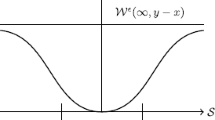Abstract
The brittle fracture of solids subject to extreme differential stress is assumed to be a consequence of the sequential fusion of smaller cracks into larger ones. Renormalization methods quantitatively describe the dynamics of the cascade of fusion events that culminates in failure, including the observed time-to-failure versus stress scaling law.
Résumé
On pose l'hypothèse que la rupture fragile des solides soumis à des contraintes différentielles est une conséquence de la fusion en série de petites fissures en de grandes.
Des méthodes de renormalisation décrivant de manière quantitative la dynamique qui préside à la cascade de fusion conduisant à l'extrême à la rupture, y compris la durée à rupture par rapport à la loi de croissance de la contrainte.
Similar content being viewed by others
References
L. Seaman, “Development of Computational Models for Microstructural Features,” Conference on Shock Waves in Condensed Matter, June 1981, Menlo Park, California, American Physical Society (1981).
B.B.Mandelbrot, D.E.Passoja, and A.J.Paullay, Nature 308 (1984) 721–722.
Y.Y.Kagan and L.Knopoff, Geophysical Journal, Royal Astronomical Society 55 (1978) 67–86.
Y.Y.Kagan and L.Knopoff, Geophysical Journal, Royal Astronomical Society 62 (1980) 303–329.
W.I.Newman and L.Knopoff, Geophysical Research Letters 9 (1982) 735–738.
W.I.Newman and L.Knopoff, Geophysical Research Letters 10 (1983) 305–308.
D.T.Griggs, Bulletin of the Geological Society of America 51 (1940) 1001–1022.
J.L.Glathart and F.W.Preston, Journal of Applied Physics 17 (1946) 189.
Z.N.Zhurkov, International Journal of Fracture Mechanics 1 (1965) 311–323.
R.L.Kranz, W.J.Harris, and W.L.Carter, Geophysical Research Letters 9 (1982) 1–4.
W.F.Brace and E.G.Bombolakis, Journal of Geophysical Research 68 (1963) 3709–3713.
T. Okada, PhD. thesis, School of Engineering and Applied Science, University of California, Los Angeles, California (1982).
G.Sines and T.Okada, Journal of the American Ceramic Society 66 (1983) 228–232.
C.J.Allegré, J.L.LeMouel, and A.Provost, Nature 297 (1982) 47–49.
W.I.Newman, Journal of Theoretical Biology 85 (1981) 325–334.
W.I.Newman, Journal of Theoretical Biology 104 (1983) 473–484.
B.Mandelbrot, The Fractal Geometry of Nature, W.H. Freeman, San Francisco (1982).
Y.Y.Kagan, Geophysical Journal, Royal Astronomical Society 71 (1982) 659–691.
G.W.Castellan, in Physical Chemistry, 2nd edn, Addison-Wesley, Reading, Massachusetts (1971) 746, 770.
C.W.Lung and Z.G.Mu, Theoretical and Applied Fracture Mechanics 6 (1986) 171–174.
T.R.Madden, Journal of Geophysical Research 88 (1983) 585–592.
C.Sparrow, Journal of Theoretical Biology 83 (1980) 93–105.
Author information
Authors and Affiliations
Rights and permissions
About this article
Cite this article
Newman, W.I., Knopoff, L. Scale invariance in brittle fracture and the dynamics of crack fusion. Int J Fract 43, 19–24 (1990). https://doi.org/10.1007/BF00018124
Received:
Accepted:
Issue Date:
DOI: https://doi.org/10.1007/BF00018124




